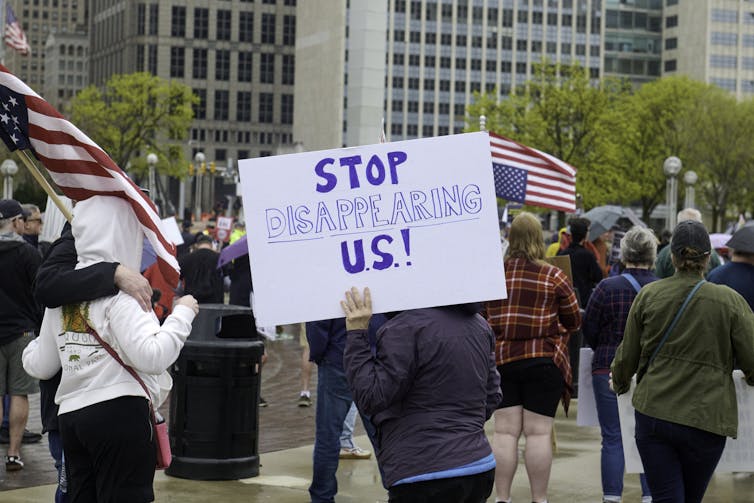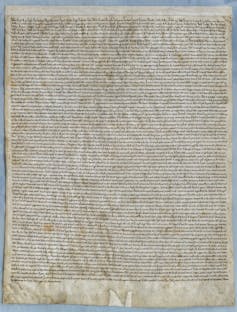Habeas corpus: A thousand-year-old legal principle for defending rights that’s getting a workout under the Trump administration
- Habeas corpus is a thousand-year-old legal principle that protects individuals from being illegally confined or detained without due process, and its use has been on the rise under the Trump administration.
- The concept of habeas corpus dates back to the 39th Clause of the Magna Carta signed by King John in 1215, which formally established the idea that no person shall be deprived unjustly of liberty.
- Habeas corpus has been used to challenge a range of issues beyond imprisonment, including interference with child custodial rights, military induction, and banishment from tribal lands, and its scope extends to securing physical release, dismissal of criminal charges, and remediation of cruel conditions of confinement.
- The Supreme Court has reaffirmed the validity of using habeas corpus in cases stemming from national security concerns, including the Sept. 11 attacks, and has ruled that even foreign detainees have the right to challenge their detention in US courts.
- Detained individuals have been blocked from using habeas corpus less than a handful of times in American history, and its suspension is only allowed in cases of rebellion or invasion when public safety may require it, as stated in Article I of the Constitution.

In some parts of the world, a person may be secreted away or imprisoned by the government without any advanced notification of wrongdoing or chance to make a defense. This has not been lawful in the United States from its very inception, or in many other countries where the rule of law and respect for individual civil rights are paramount.
The legal doctrine of “habeas corpus,” a Latin phrase that has its American roots in English law as early as the 12th century, stands as a barrier to unlawful arrest.
In its essence, habeas corpus protects any person, whether citizen or not, from being illegally confined. Habeas corpus is Latin for “you shall have the body” and requires a judge literally to have the body of any incarcerated person brought physically forward so that the legality of their detention may be assessed.
That is why habeas, sometimes also called the “Great Writ,” is front and center right now in many of the lawsuits challenging the Trump administration’s arrest and deportation of noncitizen students, scholars, humanitarian refugees and others.
In an April 7, 2025, decision in a habeas corpus case brought by lawyers from the American Civil Liberties Union representing Venezuelans who faced deportation, the Supreme Court reaffirmed that the government must give those it aims to deport the opportunity to legally challenge their removal from the U.S. This chance for due process when deprived of liberty is what habeas corpus is and does.
Since then, several federal judges have issued habeas writs blocking certain deportations from the U.S. and even movement of potential deportees from one state to another.

Dominic Gwinn, Middle East Image / Middle East Images via AFP
Habeas corpus’s deep roots
The idea that no person shall be deprived unjustly of liberty formally dates to the 39th Clause of the Magna Carta signed by England’s King John in 1215.
The Magna Carta itself was, as the U.K. parliament describes it, “the first document to put into writing the principle that the king and his government was not above the law.”
Although the writ originally was a means of enforcing the king’s power over his subjects, as noted by the Supreme Court in reviewing the writ’s long history, English judges over time issued habeas corpus “to enforce the King’s prerogative to inquire into the authority of a jailer to hold a prisoner.”
The idea crossed the ocean to play an important part in the formation of the U.S. constitutional form of democracy. As the Supreme Court emphasized in a 2008 case holding that the habeas corpus privilege existed even for “aliens” designated as enemy combatants and detained at Guantanamo Bay: “Protection for the privilege of habeas corpus was one of the few safeguards of liberty specified in a Constitution that, at the outset, had no Bill of Rights.”
In the Federal Judiciary Act of 1789, which created lower federal courts following the ratification of the Constitution, Congress gave immediate power to the federal courts to issue habeas corpus relief.
Congress expanded the right in 1867 to permit habeas corpus challenges to unlawful actions by state and local officials. This enabled people who were still held in slavery or indentured servitude, or otherwise detained in state jails, to seek release in federal court. This legislation also established the framework, still recognized today, for state prisoners to attack the constitutionality of their state convictions in federal court.
States and some tribes also have their own habeas corpus statutes. Congress also extended habeas to allow federal challenges to detention by tribal officials via the Indian Civil Rights Act of 1968, which made many of the constitutional rights held by individuals applicable to official action by federally recognized Native American tribes. In fact, habeas corpus is the sole remedy under the Indian Civil Rights Act for challenging any of the enumerated rights in that act.
When is habeas corpus used?
The principal use of habeas corpus, historically and in more modern times, has been “to seek release of persons held in actual, physical custody in prison or jail,” as Justice Hugo Black wrote in a 1962 Supreme Court opinion.
Its scope extends well beyond imprisonment, however. Habeas has been the vehicle for challenging interference with child custodial rights, involuntary commitment to inpatient treatment or psychiatric care, military induction, restrictive conditions of pretrial release, probation or parole, and banishment from tribal lands, to name a few examples.
Besides securing the physical release of imprisoned persons, habeas corpus may result in dismissal of criminal charges, new trials or appeals, the appointment of legal counsel, and court orders directing remediation of cruel or inhumane conditions of confinement.

The National Archives
Critical safeguard of liberty
Detained individuals have been blocked from using habeas corpus less than a handful of times in American history.
In the words of the Constitution’s Article I, which governs congressional power: “The Privilege of the Writ of Habeas Corpus shall not be suspended, unless when in Cases of Rebellion or Invasion the public Safety may require it.”
For example, it was suspended by President Abraham Lincoln during the Civil War; in Hawaii after the 1941 bombing of Pearl Harbor; during rebellions in 11 South Carolina counties overtaken by the Ku Klux Klan during Reconstruction in the years just after the Civil War; and in certain provinces of the U.S.-controlled Philippines in 1905.
Significantly, however, habeas relief has remained vital to challenges to presidential orders and congressional enactments even during times of war and other national security concerns.
The Supreme Court reaffirmed the validity of using habeas corpus in many efforts to suspend or limit the writ in cases stemming from the Sept. 11, 2001, attacks.
In November 2001, President George W. Bush issued a military order authorizing the indefinite detention of noncitizens suspected of being connected to terrorism. Under that order, Yaser Hamdi, who was an American citizen, was detained in U.S. military facilities without being charged, without legal counsel or the possibility of court hearings after being accused of fighting for the Taliban against the United States.
In a 2004 ruling on Hamdi’s case against the government, the Supreme Court upheld the right of every American citizen to use habeas corpus, even when declared to be an enemy combatant.
The court later ruled that Congress’ efforts to impose similar limits with respect to noncitizens being detained at Guantanamo Bay under the Military Commissions Act of 2006 were an unconstitutional abridgment of habeas corpus rights.
In the 2004 landmark case of Rasul v. Bush, the Supreme Court reaffirmed limits on when habeas corpus can be suspended – and when it cannot. The justices said that even foreign detainees captured in countries around the world and brought to Guantanamo Bay on suspected ties to terrorism had the right to challenge their detention in U.S. courts.
As these cases affirm, “Neither citizenship nor territoriality have been determined to be essential to the exercise of the writ.”
Habeas corpus is a critical safeguard of liberty. In the words of Chief Justice John Marshall in the seminal 1803 case, Marbury v. Madison, the “very essence” of civil liberty is “the right to claim the protection of the laws, whenever he receives an injury.”
![]()
Andrea Seielstad does not work for, consult, own shares in or receive funding from any company or organization that would benefit from this article, and has disclosed no relevant affiliations beyond their academic appointment.
